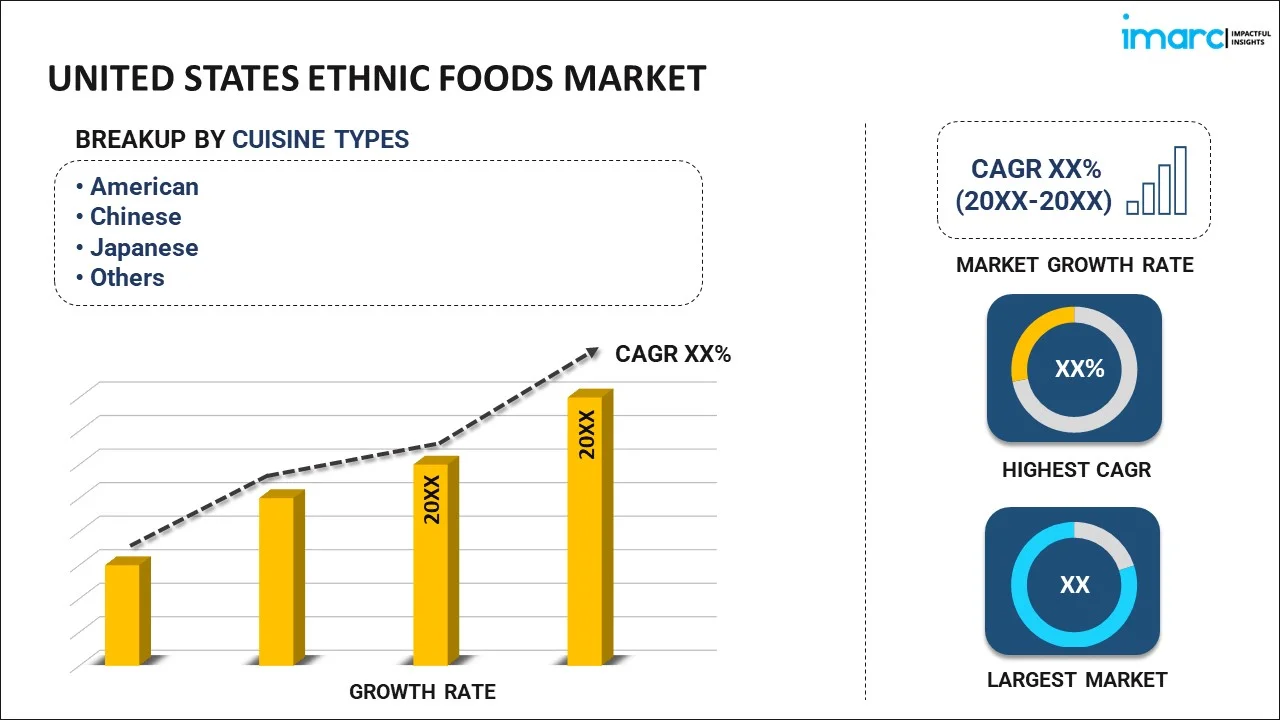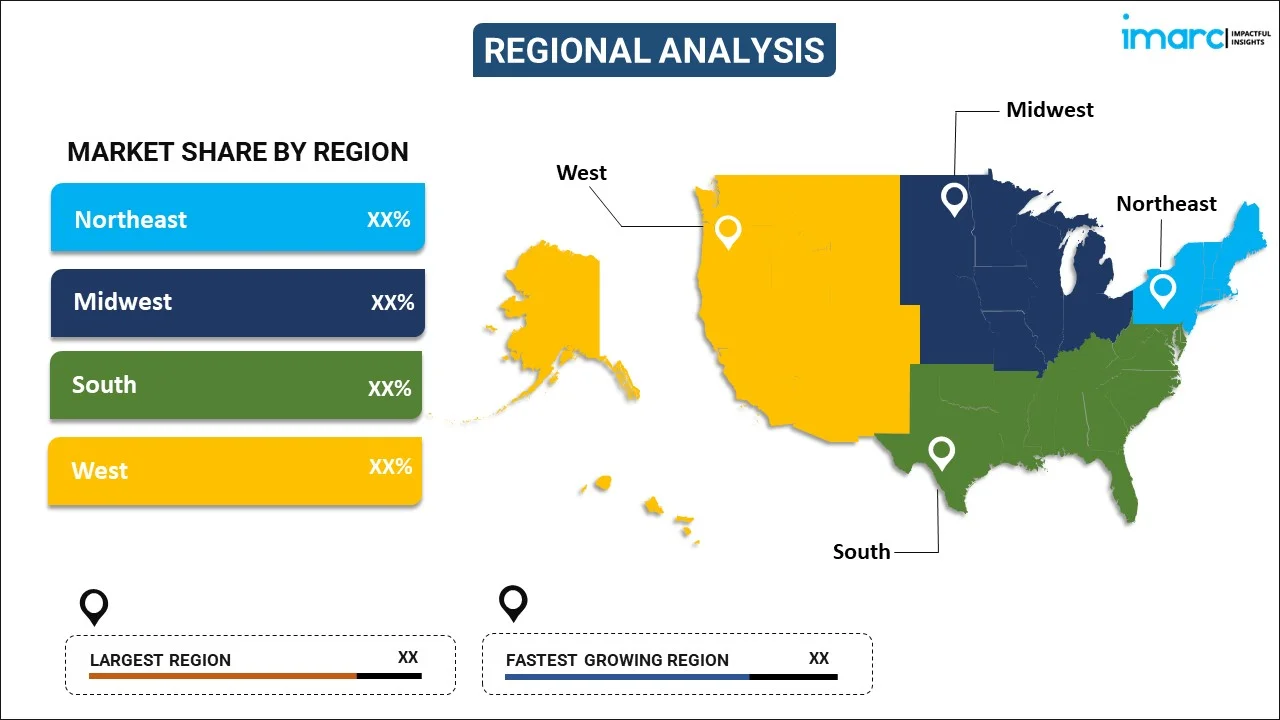
United States Ethnic Foods Market Report by Cuisine Type (American, Chinese, Japanese, Mexican, Italian, and Others), Food Type (Vegetarian, Non-Vegetarian), Distribution Channel (Food Services, Retail Stores), and Region 2025-2033
Market Overview:
The United States ethnic foods market size reached USD 29.2 Billion in 2024. Looking forward, IMARC Group expects the market to reach USD 56.1 Billion by 2033, exhibiting a growth rate (CAGR) of 7.3% during 2025-2033. The growing health and wellness trends, increasing cultural diversity and immigration, rapid globalization and food accessibility, and the rising influence of celebrity chefs and food-related media, represent some of the key factors driving the market.
|
Report Attribute
|
Key Statistics
|
|---|---|
|
Base Year
|
2024 |
|
Forecast Years
|
2025-2033 |
|
Historical Years
|
2019-2024
|
| Market Size in 2024 | USD 29.2 Billion |
| Market Forecast in 2033 | USD 56.1 Billion |
| Market Growth Rate (2025-2033) | 7.3% |
Ethnic foods encompass a broad spectrum of culinary delights that originate from various cultural and regional traditions around the world. These foods are distinct in flavor, preparation techniques, and ingredients, representing the cultural heritage and culinary expertise of different ethnic or cultural groups. From fragrant Indian curries to savory Italian pasta dishes, spicy Mexican tacos to delicate Japanese sushi, and flavorful Middle Eastern kebabs to aromatic Thai stir-fries, ethnic foods offer a diverse and rich array of tastes and experiences. Restaurants and food manufacturers are also catering to this demand, incorporating ethnic dishes into their menus and product offerings. Additionally, the availability of authentic ethnic ingredients in supermarkets and online stores is making it easier for consumers to experiment with and prepare these dishes at home. Ethnic foods not only offer a delicious dining experience but also serve as a medium for cultural exchange and appreciation. They provide a window into the history, traditions, and values of diverse communities, fostering a sense of connection and understanding among people from different backgrounds.
United States Ethnic Foods Market Trends:
The rising influence of celebrity chefs and food-related media represents one of the key factors driving the growth of the market across the United States. Cooking shows, food documentaries, and celebrity chefs' promotion of diverse cuisines have generated interest and curiosity among viewers, inspiring them to explore and try ethnic dishes. The culinary expertise and storytelling of these influencers are helping build cultural bridges through food, which is encouraging consumers to appreciate the nuances and stories behind different ethnic dishes. With steadily increasing immigrant and expatriate population base in the country, there is a rising demand for ethnically diverse cuisines. In line with this, the inclination to connect with one's roots and explore new flavors is leading to an increased interest in ethnic foods, which is prompting restaurants, specialty stores, and food manufacturers to cater to these diverse preferences. Advances in transportation and communication technologies are facilitating the import and distribution of ingredients and products from around the world. This globalization is making it easier for restaurants and retailers to source authentic ethnic ingredients, which is enabling them to offer a wider variety of ethnic foods to meet consumer demand. In addition to this, the rise of e-commerce is making it possible for consumers to access ethnic ingredients and ready-to-eat meals from various cultures, regardless of their geographical location, which is creating a positive outlook for the market across the country.
United States Ethnic Foods Market Segmentation:
IMARC Group provides an analysis of the key trends in each segment of the United States ethnic foods market report, along with forecasts at the country level for 2025-2033. Our report has categorized the market based on cuisine type, food type, and distribution channel.
Cuisine Type Insights:

- American
- Chinese
- Japanese
- Mexican
- Italian
- Others
The report has provided a detailed breakup and analysis of the market based on the cuisine type. This includes American, Chinese, Japanese, Mexican, Italian, and others.
Food Type Insights:
- Vegetarian
- Non-Vegetarian
A detailed breakup and analysis of the market based on the food type has also been provided in the report. This includes vegetarian and non-vegetarian. According to the report, xx accounted for the largest market share.
Distribution Channel Insights:
- Food Services
- Retail Stores
A detailed breakup and analysis of the market based on the distribution channel has also been provided in the report. This includes food services and retail stores.
Regional Insights:

- Northeast
- Midwest
- South
- West
The report has also provided a comprehensive analysis of all the major regional markets, which include Northeast, Midwest, South, and West.
Competitive Landscape:
The report has also provided a comprehensive analysis of the competitive landscape in the United States ethnic foods market. Competitive analysis such as market structure, key player positioning, top winning strategies, competitive dashboard, and company evaluation quadrant has been covered in the report. Also, detailed profiles of all major companies have been provided.
United States Ethnic Foods Market Report Coverage:
| Report Features | Details |
|---|---|
| Base Year of the Analysis | 2024 |
| Historical Period | 2019-2024 |
| Forecast Period | 2025-2033 |
| Units | Billion USD |
| Scope of the Report | Exploration of Historical and Forecast Trends, Industry Catalysts and Challenges, Segment-Wise Historical and Predictive Market Assessment:
|
| Cuisine Types Covered | American, Chinese, Japanese, Mexican, Italian, Others |
| Food Types Covered | Vegetarian, Non-Vegetarian |
| Distribution Channels Covered | Food Services, Retail Stores |
| Regions Covered | Northwest, Midwest, South, West |
| Customization Scope | 10% Free Customization |
| Post-Sale Analyst Support | 10-12 Weeks |
| Delivery Format | PDF and Excel through Email (We can also provide the editable version of the report in PPT/Word format on special request) |
Key Questions Answered in This Report:
- How has the United States ethnic foods market performed so far and how will it perform in the coming years?
- What has been the impact of COVID-19 on the United States ethnic foods market?
- What is the breakup of the United States ethnic foods market on the basis of cuisine type?
- What is the breakup of the United States ethnic foods market on the basis of food type?
- What is the breakup of the United States ethnic foods market on the basis of distribution channel?
- What are the various stages in the value chain of the United States ethnic foods market?
- What are the key driving factors and challenges in the United States ethnic foods market?
- What is the structure of the United States ethnic foods market and who are the key players?
- What is the degree of competition in the United States ethnic foods market?
Key Benefits for Stakeholders:
- IMARC’s report offers a comprehensive quantitative analysis of various market segments, historical and current market trends, market forecasts, and dynamics of the United States ethnic foods market from 2019-2033.
- The research study provides the latest information on the market drivers, challenges, and opportunities in the United States ethnic foods market.
- Porter's five forces analysis assist stakeholders in assessing the impact of new entrants, competitive rivalry, supplier power, buyer power, and the threat of substitution. It helps stakeholders to analyze the level of competition within the United States ethnic foods industry and its attractiveness.
- Competitive landscape allows stakeholders to understand their competitive environment and provides an insight into the current positions of key players in the market.
Need more help?
- Speak to our experienced analysts for insights on the current market scenarios.
- Include additional segments and countries to customize the report as per your requirement.
- Gain an unparalleled competitive advantage in your domain by understanding how to utilize the report and positively impacting your operations and revenue.
- For further assistance, please connect with our analysts.
 Inquire Before Buying
Inquire Before Buying
 Speak to an Analyst
Speak to an Analyst
 Request Brochure
Request Brochure
 Request Customization
Request Customization




.webp)




.webp)












